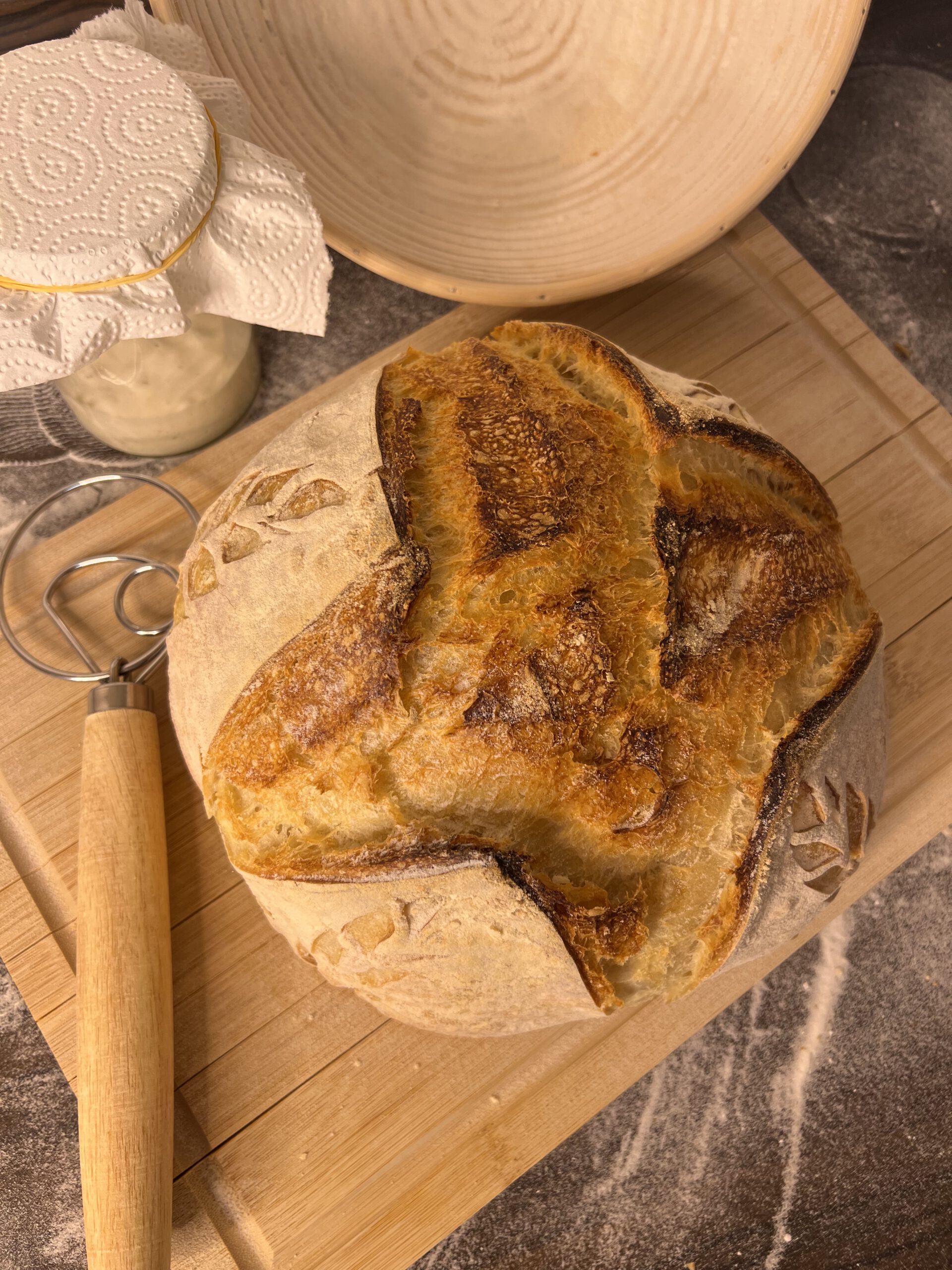Easy Homemade Sourdough Bread

Sourdough bread has made a huge comeback in recent years, and for good reason. Baking your own loaf at home is not only rewarding but also healthier and more flavorful than most store-bought bread. With just a few basic ingredients, a little patience, and the magic of fermentation, you can create a crusty, golden loaf that tastes amazing fresh out of the oven.
Table of Contents
Why Bake Sourdough at Home?
When you bake sourdough yourself, you know exactly what goes into your bread. Unlike commercial loaves that often contain additives, sugar, and preservatives, sourdough is built on three simple ingredients: flour, water, and salt. The fermentation process takes care of the rest, developing flavor, texture, and nutritional value naturally.
There is also something deeply satisfying about turning simple ingredients into a beautiful loaf. The process may take time, but it teaches patience and brings a sense of accomplishment that makes every slice taste even better.
The Benefits of Homemade Sourdough
Homemade sourdough offers a long list of benefits that go beyond taste. Slow fermentation helps break down gluten, which can make the bread easier to digest for many people. The natural fermentation also increases the bioavailability of nutrients, meaning your body can absorb more from each bite.
The flavor of sourdough is unlike any other bread. Instead of being one-dimensional, it has layers of tanginess and subtle sweetness that develop as the dough ferments. The crust turns perfectly golden and crisp, while the inside stays soft and airy. Once you have tried homemade sourdough, it is hard to go back to standard bread.
Understanding Wild Fermentation
At the heart of sourdough is fermentation. Rather than using store-bought yeast, sourdough relies on wild yeasts and lactic acid bacteria that naturally live in flour and the surrounding environment. These microorganisms work together to transform the dough.
During fermentation, the wild yeast consumes sugars in the flour, releasing carbon dioxide that makes the bread rise. Meanwhile, lactic acid bacteria create the tangy flavor sourdough is known for. This process not only develops taste but also helps preserve the bread, giving it a longer shelf life than ordinary loaves.
Key Tips for Perfect Sourdough
While sourdough baking takes practice, there are a few key tips that can help you succeed from the start:
- Use strong bread flour to ensure good gluten development.
- Keep your starter active and bubbly for a reliable rise.
- Allow enough time for bulk fermentation and proofing. Rushing the process will affect flavor and texture.
- Bake your loaf in a preheated Dutch oven to trap steam and create that crackly crust.
Small changes in temperature, hydration, or timing can make a big difference. Over time, you will learn how your dough behaves and what works best in your kitchen.
How to Make Easy Homemade Sourdough Bread
To make a simple loaf, start with an active sourdough starter. Mix it with flour, water, and salt until you have a shaggy dough. Let it rest and then fold it several times to build strength. After bulk fermentation, shape the dough into a round and let it rise in a proofing basket.
When it is ready, transfer the dough into a hot Dutch oven and bake until golden brown. The result is a crusty loaf with an open crumb and rich flavor. Each step may seem small, but together they create something truly special.
Embracing the Tradition
Baking sourdough bread is more than just a recipe. It is a tradition that has been passed down for centuries. Every loaf tells a story of patience, care, and connection to real food. Whether you are completely new to baking or looking to refine your technique, sourdough offers endless opportunities to learn and enjoy.
Once you pull your first loaf from the oven, you will understand why so many people fall in love with this style of bread. With a little practice, sourdough baking can become a natural part of your routine, filling your home with the smell of fresh bread and your kitchen with loaves worth sharing.
How to Make Sourdough Bread

Easy Homemade Sourdough Bread
Ingredients
Method
- The night before baking, feed your sourdough starter in a 1:2:2 ratio (starter:water:flour). For example, if using 30g of starter, mix it with 60g water and 60g flour. Let it sit overnight at room temperature until it reaches its peak activity, this is when it’s bubbly and has doubled in size.
- In the morning, mix your flour and water in a bowl until no dry spots remain. Let the mixture rest for 30 minutes. This process, called autolyse, allows the flour to fully absorb the water, beginning the gluten development, which helps create a more elastic and extensible dough.
- Add active sourdough starter and salt. Mix until well combined. Let the dough rest for 30 minutes before proceeding to the next step.
- Perform a series of stretch and folds to strengthen the dough:1. Grab a portion of the dough, stretch it upward, and fold it over the center.2. Rotate the bowl and repeat until all sides have been stretched and folded.3. Let the dough rest for 30 minutes, then repeat the stretch and fold process.4. Complete four rounds of stretch and folds, each separated by a 30-minute rest. You will notice the dough becoming stronger and smoother with each round.
- After the last fold, cover and let rise until doubled in size (3–6 hours). The timing depends on the temperature in your kitchen. It’s important to watch the dough, not the clock!
- Once the dough has doubled in size you will pre-shape the dough:1. Lightly flour your work surface and wet your hands to prevent sticking.2. Gently stretch the dough into a rectangular shape, being careful not to tear it.3. Fold the left and right sides into the middle, then roll it up to create tension.Place your dough into a floured proofing basket (or a bowl lined with a floured kitchen towel). Using rice flour helps prevent sticking. Cover and refrigerate overnight (12–16 hours).
- The next morning:1. Preheat your oven to 250°C (480°F) with the Dutch oven inside2. Carefully remove the dough from the fridge and place it onto parchment paper.3. Use a sharp blade or lame to score the dough, allowing it to expand while baking.
- Place the dough into the hot Dutch oven, cover with the lid, and bake for 20 minutes. This traps steam, creating a beautiful rise.After 20 minutes, remove the lid, lower the temperature to 220°C (430°F), and bake for another 20–25 minutes until deep golden brown.Alternative: If you don’t have a Dutch oven, bake the bread on a hot baking stone or tray and create steam by adding a dish with hot water to the oven.
- Carefully remove the bread from the oven and tap the bottom. It should sound hollow. Let the loaf cool completely on a wire rack for at least 1 hour before slicing. Cutting too soon can result in a gummy texture.

